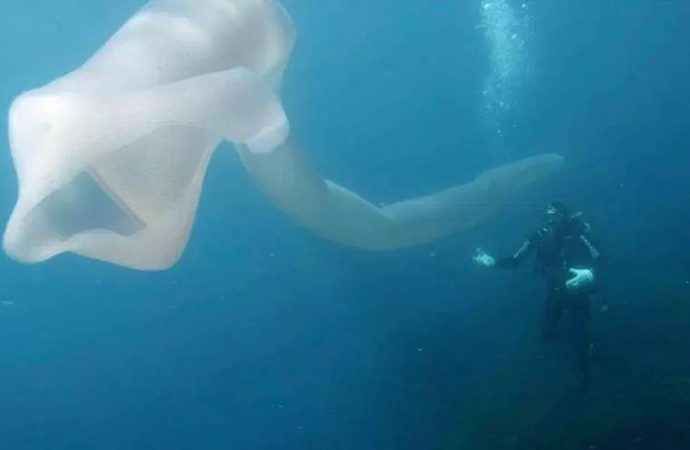Sea squirt. Fire body. Cockroach of the sea. These bizarre, glowing creatures can measure 26 feet or longer.
When videographer Steve Hathaway was filming a tourism promo on October 25 on an island off the coast of New Zealand, his friend Andrew Buttle called him over to see something weird.
“You’ve got to be kidding me,” Hathaway says he thought upon hearing what Buttle found. He put on his scuba gear and dove in. It was a 26-foot long translucent worm-like creature that looked like a giant wind sock. It was a pyrosome—big enough for him to swim through—and he’d been looking forward to catching a glimpse of one for years.
That’s because a pyrosome isn’t just one animal—it’s a free-flowing colony of hundreds or thousands of individual organisms called zooids. Zooids themselves are small multicellular creatures that filter feed by pumping water through their bodies and catching phytoplankton, bacteria, poop particles from animals, and anything else they can clean up.
This process of pumping water in one siphon and out another makes them part of a group known as tunicates, or “sea squirts.” Another nickname? “Cockroaches of the sea,” for their ability to sieve food out of even the least hospitable environments.
The pyrosome and its cousin, the salp, are both “hugely important and super abundant” in mainly tropical waters as a food source, says Andrew Jeffs, professor of marine science at the University of Auckland. Both are food for sea creatures, including turtles and, Jeffs’ specialty, spiny lobsters. Predators can cling to the tubes for weeks and dine.
“It’s like if we humans hang off an elephant and eat it,” he says. “They can afford to take the time and munch enough to get the goodness out of them.” However, animals often die from mistakenly eating plastic bags that look like them and other gelatinous organisms like jellyfish.
To feed, pyrosomes swim vertically to the ocean surface at night to catch phytoplankton and then return to the depths when daylight comes, perhaps to avoid daytime-feeding predators.
These gelatinous, tubular bodies glow from natural bioluminescence, which is how they got the name pyrosome, which comes from the Greek for “fire” and “body.” They can be as small as a centimeter or as big as (or bigger than) the one in the video.
That building process includes both sexual and asexual reproduction, says Moira Decima, zooplankton ecologist at the National Institute of Water and Atmospheric Research in Wellington. They grow rapidly, though how quickly exactly is hard to pin down. There is more research on salps, which are made of one zooid and are more common, than pyrosomes.
That may change, however. Decima points out a huge pyrosome bloom on the United States West Coast in 2017 and says more efforts are being made to understand these creatures.
Buttle and Hathaway, both experienced divers, managed to spot this particular pyrosome during the warm season in New Zealand. The island of Whakaari, which Buttle inherited from his grandfather, sits about 30 miles off the mainland. Also known as the White Island, it is a tourist attraction known for its active stratovolcano.
The higher temperatures from the summer season invite different ocean life. “You always see something new around this time,” Hathaway says. He had already seen enough ocean life from an 11-year-long videography career, including manta rays and whales. This time, he and Buttle both ended up swimming around the pyrosome for about forty minutes.
One thing he wants to take from this experience, he says, is to add it to his educational entertainment platform for children, Young Ocean Explorers. “I know the kids will love it,” he says. “To them, it looks like a giant worm. Sometimes, it takes something strange to stop people in their tracks.”
Source: National Geographic
Go to the National Grographic for the video of the strange creature.

































Leave a Comment
You must be logged in to post a comment.